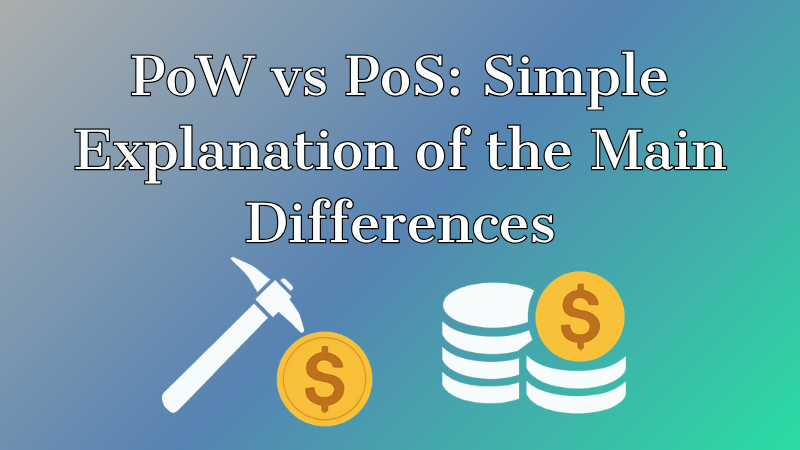PoW vs PoS: Simple Explanation of the Main Differences
If you’ve ever asked yourself what proof of work vs proof of stake is, we’re here to answer. Blockchains use these two methods to stay secure and confirm transactions. They both do the same job, but in different ways.
This article will explain the difference between PoW and PoS in simple, easy-to-understand language.
Key Takeaways
- PoW uses miners who solve puzzles – it’s secure but uses a lot of energy (like Bitcoin).
- PoS lets people lock up coins to help run the network – it’s much more energy-efficient (like Ethereum).
- PoW needs powerful computers and electricity; PoS doesn’t.
- In PoS, anyone with enough coins can join, making it more open.
- Choosing PoW or PoS affects how eco-friendly and scalable a blockchain is.
What is Proof of Work (PoW)?
Proof of Work (PoW) is a consensus mechanism that blockchain networks use to confirm transactions and add new blocks. It requires miners to solve complex cryptographic puzzles, using computational resources, before they can propose a block to the blockchain.
How PoW works
In Proof of Work (PoW), miners solve complex cryptographic puzzles to validate transactions and create new blocks on the blockchain. They use powerful computers to compete with each other in solving these puzzles.
The first miner who solves the puzzle gets the chance to add a new block to the blockchain and earns cryptocurrencies as a reward.

This process requires a lot of computational resources and energy. Miners invest in advanced hardware to increase their chances of solving puzzles first.
The security of PoW comes from the difficulty of these puzzles, making it nearly impossible for attackers to alter any transaction data within the blockchain without controlling more than half of the network’s computing power.
Main Features and Examples of PoW
Proof of work uses cryptographic puzzles to secure blockchain networks. Miners compete to solve complex problems. The first miner to find a solution gets the right to propose the next block and earn tokens as a reward.
Bitcoin, created in 2009, is one of the most famous examples of PoW. It uses this process to validate transactions while ensuring network security.
Energy consumption remains a significant concern for PoW systems. Mining requires substantial computational resources and electricity, leading some critics to argue against its sustainability.
Ethereum also started with PoW before transitioning to Proof of Stake. This change reflects an industry-wide effort toward more efficient consensus algorithms that require less energy.
What is Proof of Stake?
Proof of stake (PoS) allows users to validate transactions based on the number of tokens they hold. Instead of solving cryptographic puzzles, validators earn rewards by staking their coins and maintaining network security.
How PoS works
Proof of stake selects validators based on the number of tokens they hold and are willing to “stake.” Instead of solving complex cryptographic puzzles like in Proof of Work, validators propose new blocks at random.

This method uses less energy and requires fewer computational resources. The more tokens a person stakes, the higher their chances of being chosen as a validator.
Validators earn rewards for helping secure the network. They confirm transactions and validate blocks without needing intense mining operations. Anyone can become a validator if they meet staking requirements, promoting decentralization within the blockchain.
Main Features and Examples of PoS
Proof of Stake promotes energy efficiency. Validators replace miners and secure the blockchain by holding tokens. This system lowers energy consumption compared to Proof of Work, which relies on complex cryptographic puzzles. Users earn rewards by staking their tokens for a chance to validate transactions.
Ethereum is a well-known example of PoS in action. The network switched from PoW to PoS in 2022, demonstrating its commitment to sustainability while improving scalability.
Other cryptocurrencies like Cardano and Solana also use this method, proving that PoS can support secure and decentralized digital currency systems effectively.
Differences Between Proof of Work and Proof of Stake
Below, we will discuss the main differences between Proof of Work and Proof of Stake.
Energy consumption
Energy consumption varies greatly between Proof of Work and Proof of Stake. PoW requires significant computational resources. Miners solve intricate cryptographic challenges to verify transactions and add blocks to the blockchain. This process uses a lot of electricity, especially for large networks like Bitcoin. In fact, Bitcoin’s energy usage often exceeds that of entire countries.
In contrast, PoS relies on validators who hold tokens to secure the network. This method consumes far less energy because it eliminates intensive mining activities. Validators create new blocks based on the number of tokens they stake, making it more efficient.
Security and scalability
Security and scalability differ greatly between Proof of Work and Proof of Stake. PoW relies on miners who solve cryptographic puzzles to validate transactions. This process consumes a lot of energy, which raises concerns about its environmental impact.
In contrast, PoS uses validators who stake tokens to secure the network. Because it requires fewer computational resources, PoS offers better scalability for handling increased transaction volumes.
PoW vs PoS vs PoA
In the table below, you’ll see the main differences between PoW, PoS, and PoA in a simple way.
| Feature | PoW (Proof of Work) | PoS (Proof of Stake) | PoA (Proof of Authority) |
|---|---|---|---|
| How it works | Miners solve puzzles to add blocks | Validators lock coins to get selected | Pre-approved validators add blocks |
| Energy usage | High | Low | Very low |
| Speed | Slower | Faster than PoW | Very fast |
| Who can participate | Anyone with hardware | Anyone with enough coins | Only trusted validators |
| Used by | Bitcoin, Litecoin | Ethereum, Cardano | VeChain, Palm, some private blockchains |
| Security | Very secure, but energy-heavy | Secure, depends on stake distribution | Secure but more centralized |
| Decentralization | High | Medium to high | Low |
The Future of PoS vs PoW
In the future, more blockchains will likely use Proof of Stake because it uses less energy and works faster. It’s better for the environment and easier to scale. Proof of Work is still very safe and trusted, especially for Bitcoin, but it needs a lot of power and electricity.
Because of that, PoW may not be the best choice for new projects. Many people think PoS is the better option moving forward, especially for saving energy and handling more users.
Bottom Line About PoW vs PoS
Understanding the difference between PoW and PoS helps you see how blockchains stay secure and why some use more energy than others. If you’re interested in crypto investing, it’s good to know that coins like Bitcoin use PoW, while Ethereum, Cardano, and Solana use PoS.
PoS networks are generally faster, cheaper to run, and more eco-friendly. When choosing a crypto project to follow or invest in, check which system it uses — it can affect long-term growth, fees, and sustainability.
FAQs About PoW Vs PoS
PoW uses miners who solve puzzles with powerful computers. PoS uses people who lock up coins (stake) to help run the network.
PoS uses much less energy because it doesn’t need heavy computing like PoW does.
Yes. Both are secure. PoW is protected by computing power, while PoS is secured by people staking their coins and following the rules.
Yes. If you stake your coins, you can earn rewards for helping keep the network safe.
PoW is more secure but uses more energy. PoS is faster, eco-friendly, and better for most new projects. PoS is often seen as the more modern and sustainable option.
Proof of Work uses miners to solve complex puzzles, consuming high energy, while Proof of Stake selects validators based on staked cryptocurrency, offering a more energy-efficient method.
PoS is more energy-efficient and scalable, while PoW is considered more secure but consumes more energy.






